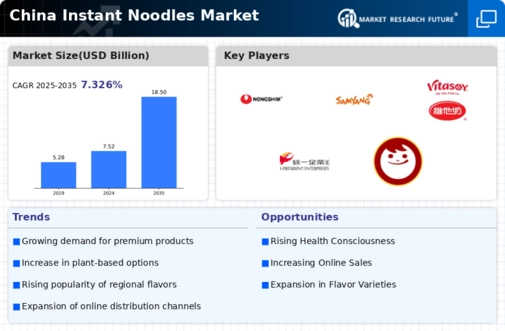Rising Urbanization
The rapid urbanization in China is a pivotal driver for the instant noodles market. As more individuals migrate to urban areas, the demand for convenient food options increases. Urban dwellers often lead busy lifestyles, which necessitates quick meal solutions. In 2025, urbanization in China is projected to reach approximately 65%, leading to a heightened consumption of instant noodles. This trend indicates that the instant noodles market is likely to benefit from the growing population in cities, where time constraints make instant noodles an appealing choice. Furthermore, the availability of diverse flavors and packaging options in urban centers enhances the attractiveness of instant noodles, making them a staple for many households. The instant noodles market is thus poised for growth as urbanization continues to reshape dietary habits.
Innovative Packaging Solutions
The evolution of packaging technology is a notable driver for the instant noodles market in China. Innovative packaging solutions enhance product appeal and convenience, catering to the needs of modern consumers. In 2025, the introduction of eco-friendly packaging options is expected to gain traction, as environmental concerns become more prominent among consumers. The instant noodles market is likely to see a shift towards sustainable packaging, which not only attracts environmentally conscious buyers but also aligns with global trends. Additionally, packaging that offers portion control and easy preparation methods can further enhance the consumer experience. This focus on packaging innovation may lead to increased sales and brand loyalty, as consumers are drawn to products that offer both convenience and sustainability.
Cultural Acceptance and Tradition
Cultural factors significantly influence the instant noodles market in China. Instant noodles have become ingrained in the culinary landscape, often associated with convenience and comfort. Traditional Chinese cuisine values quick and easy meal solutions, which aligns well with the offerings of the instant noodles market. In 2025, it is estimated that around 80% of Chinese households regularly consume instant noodles, reflecting their acceptance as a staple food. The instant noodles market thrives on this cultural acceptance, as manufacturers continue to innovate flavors that resonate with local tastes. Moreover, the integration of instant noodles into various social settings, such as gatherings and late-night snacks, further solidifies their position in the market. This cultural affinity suggests a sustained demand for instant noodles in the coming years.
Affordability and Economic Factors
Affordability plays a crucial role in the instant noodles market, particularly in China, where economic conditions influence consumer purchasing behavior. Instant noodles are often perceived as a cost-effective meal option, appealing to a wide demographic, including students and low-income families. In 2025, the average price of a pack of instant noodles is estimated to be around ¥5, making it an accessible choice for many. The instant noodles market benefits from this affordability, especially during economic fluctuations when consumers seek budget-friendly food alternatives. Additionally, the increasing disposable income among the middle class may lead to a shift in consumption patterns, where instant noodles are not only seen as a cheap meal but also as a convenient option for busy lifestyles. This dual perception could further bolster the market's growth.
Expansion of Distribution Channels
The expansion of distribution channels is a critical factor driving the instant noodles market in China. With the rise of e-commerce and modern retail formats, instant noodles are becoming more accessible to a broader audience. In 2025, online sales of instant noodles are projected to account for approximately 30% of total sales, reflecting a significant shift in consumer purchasing behavior. The instant noodles market benefits from this trend, as online platforms provide convenience and a wider variety of products. Additionally, traditional retail channels, such as supermarkets and convenience stores, continue to play a vital role in distribution. This multi-channel approach allows manufacturers to reach diverse consumer segments, thereby enhancing market penetration. The ongoing expansion of distribution channels is likely to sustain the growth trajectory of the instant noodles market.
















Leave a Comment